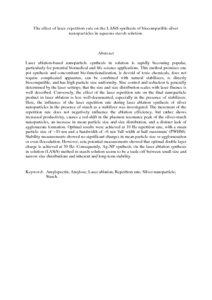Citation
Zamiri, Reza and Zakaria, Azmi and Ahangar, Hossein Abbastabar and Darroudi, Majid and Zamiri, Golnoosh and Rizwan, Zahid and Drummen, Gregor P. C.
(2013)
The effect of laser repetition rate on the LASiS synthesis of biocompatible silver nanoparticles in aqueous starch solution.
International Journal of Nanomedicine, 8.
pp. 233-244.
ISSN 1176-9114; ESSN: 1178-2013
Abstract
Laser ablation-based nanoparticle synthesis in solution is rapidly becoming popular, particularly for potential biomedical and life science applications. This method promises one pot synthesis and concomitant bio-functionalization, is devoid of toxic chemicals, does not require complicated apparatus, can be combined with natural stabilizers, is directly biocompatible, and has high particle size uniformity. Size control and reduction is generally determined by the laser settings; that the size and size distribution scales with laser fluence is well described. Conversely, the effect of the laser repetition rate on the final nanoparticle product in laser ablation is less well-documented, especially in the presence of stabilizers. Here, the influence of the laser repetition rate during laser ablation synthesis of silver nanoparticles in the presence of starch as a stabilizer was investigated. The increment of the repetition rate does not negatively influence the ablation efficiency, but rather shows increased productivity, causes a red-shift in the plasmon resonance peak of the silver-starch nanoparticles, an increase in mean particle size and size distribution, and a distinct lack of agglomerate formation. Optimal results were achieved at 10 Hz repetition rate, with a mean particle size of ~10 nm and a bandwidth of ~6 nm 'full width at half maximum' (FWHM). Stability measurements showed no significant changes in mean particle size or agglomeration or even flocculation. However, zeta potential measurements showed that optimal double layer charge is achieved at 30 Hz. Consequently, Ag-NP synthesis via the laser ablation synthesis in solution (LASiS) method in starch solution seems to be a trade-off between small size and narrow size distributions and inherent and long-term stability.
Download File
![[img]](http://psasir.upm.edu.my/29987/1.hassmallThumbnailVersion/The%20effect%20of%20laser%20repetition%20rate%20on%20the%20LASiS%20synthesis%20of%20biocompatible%20silver%20nanoparticles%20in%20aqueous%20starch%20solution.pdf)  Preview |
|
PDF (Abstract)
The effect of laser repetition rate on the LASiS synthesis of biocompatible silver nanoparticles in aqueous starch solution.pdf
Download (84kB)
| Preview
|
|
Additional Metadata
Actions (login required)
 |
View Item |

